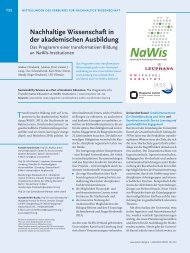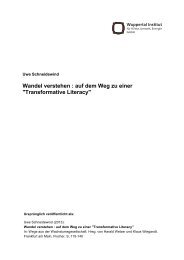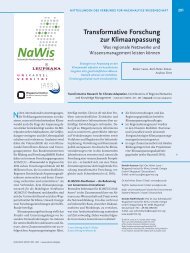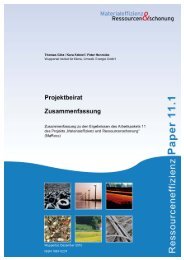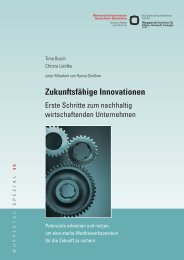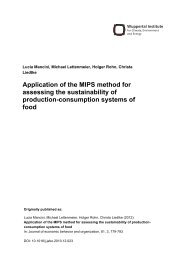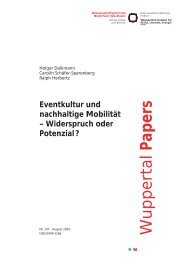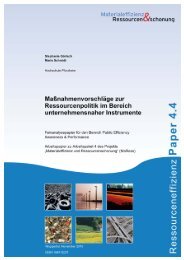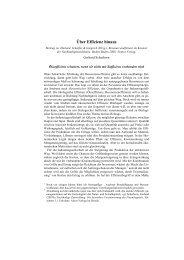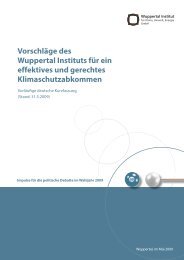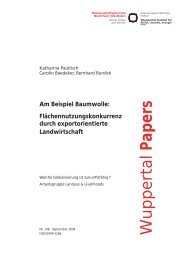Resource Efficiency Atlas - Publication Server of the Wuppertal ...
Resource Efficiency Atlas - Publication Server of the Wuppertal ...
Resource Efficiency Atlas - Publication Server of the Wuppertal ...
Create successful ePaper yourself
Turn your PDF publications into a flip-book with our unique Google optimized e-Paper software.
62<br />
Examples for resource efficiency | Strategies | Product-Service-System (use-phase)<br />
Strategies<br />
Redesign and<br />
Re-use<br />
Ressourceneffizienzatlas<br />
<strong>Resource</strong> <strong>Efficiency</strong> <strong>Atlas</strong><br />
Product-Service-System<br />
(use-phase)<br />
New production and<br />
consumption patterns<br />
New business model to reduce use <strong>of</strong> chemicals<br />
Chemical Leasing<br />
Inclusion <strong>of</strong> RE into<br />
Standards<br />
Pay for services, not products. This concept aims at an efficient use <strong>of</strong> chemicals - a business<br />
model, from which all involved parties can pr<strong>of</strong>it.<br />
Application <strong>of</strong> <strong>the</strong> concept “Chemical Leasing” could lead<br />
to decreased demand for chemicals through more efficient<br />
use. The customer pays for <strong>the</strong> service, for example,<br />
for each square meter <strong>of</strong> cleaned surface, and not for <strong>the</strong><br />
quantity <strong>of</strong> used chemicals. Aside from <strong>the</strong> chemicals, <strong>the</strong><br />
manufacturer sells <strong>the</strong> know-how for an efficient application<br />
<strong>of</strong> <strong>the</strong> respective chemicals. Depending on <strong>the</strong> leasing<br />
model <strong>the</strong> manufacturer can assume responsibility<br />
for chemical safety (industrial safety, environmental protection).<br />
In contrast to <strong>the</strong> classical business model <strong>the</strong><br />
turnover is not connected directly to <strong>the</strong> quantity <strong>of</strong> sold<br />
chemicals – in fact, <strong>the</strong> company is interested in a more efficient<br />
use <strong>of</strong> a respective chemical. This leads to reduced<br />
production costs and, thus, to a reduction in total costs.<br />
This again is beneficial for <strong>the</strong> customer.<br />
Pilot projects, which started in 2005, are testing <strong>the</strong> new<br />
concept in different fields <strong>of</strong> application; for example, in<br />
<strong>the</strong> metal working sector, where chemicals are used for<br />
cleaning, pickling, pouring, and cooling. Fur<strong>the</strong>rmore, it is<br />
tested in o<strong>the</strong>r sectors such as <strong>the</strong> chemical syn<strong>the</strong>sis (application:<br />
catalysis), food industry (application: extraction,<br />
water purification) as well as <strong>the</strong> trade sector (application:<br />
cooling <strong>of</strong> goods/refrigeration). The projects were initiated<br />
by <strong>the</strong> United Nations Industrial Development Organization<br />
(UNIDO) in co-operation with <strong>the</strong> Austrian Federal<br />
Ministry <strong>of</strong> Agriculture, Forestry, Environment and Water<br />
Management (BMLFUW). Apart from <strong>the</strong>se projects in Austria,<br />
o<strong>the</strong>r projects are carried out in developing countries<br />
such as Mexico, Egypt, and Colombia.<br />
<strong>Resource</strong> <strong>Efficiency</strong><br />
An analysis <strong>of</strong> <strong>the</strong> Austrian BMLFUW in 2002 showed that<br />
53,000 tons <strong>of</strong> chemicals, including related emissions and<br />
waste, could be saved in Austria each year if this model was<br />
implemented in all suitable sectors. This corresponds to approximately<br />
one third <strong>of</strong> all chemicals used in Austria each<br />
year. According to <strong>the</strong> market analysis “Chemical Product<br />
services into <strong>the</strong> European Union” (CPS), conducted by different<br />
universities toge<strong>the</strong>r with <strong>the</strong> Öko-Institute on behalf<br />
<strong>of</strong> <strong>the</strong> Institute for Prospective Technological Studies,<br />
a reduction <strong>of</strong> 5 to 30 percent <strong>of</strong> chemicals used each year<br />
can be reached, if CPS is implemented; depending on <strong>the</strong><br />
type and application <strong>of</strong> <strong>the</strong> chemical.<br />
Barriers and Risks<br />
For implementation <strong>of</strong> <strong>the</strong> business model all involved<br />
players (suppliers and customers) must assent to <strong>the</strong> new<br />
concept. This, however, might represent a first obstacle. Additionally,<br />
<strong>the</strong> accounting <strong>of</strong> <strong>the</strong> service causes problems<br />
since <strong>the</strong> sales unit e.g. surface or number <strong>of</strong> cleaned items,<br />
needs to be defined depending on <strong>the</strong> application. A risk



